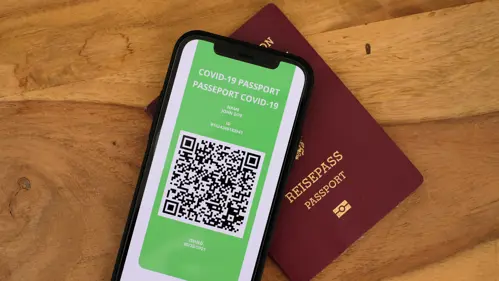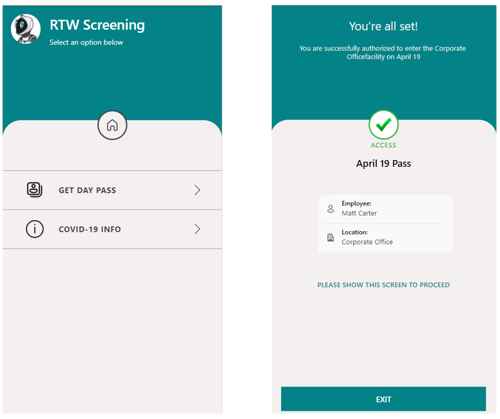IoT Digital Twin tech is making its way from non-living machinery and equipment to organic humans and market research says it'll be transformational. Read this article to learn more about how virtual presence tech is helping businesses and governments respond to new hybrid work models to keep employees and citizens healthy and safe.
Digital Twins are a growing trend for many businesses seeking to innovate and optimize through IoT. However, a digital twin can not only represent a non-living entity like a machine or a building to gain insights and automate business process but can also represent an organic entity like a human. In fact, a Digital Twin of the Person (DToP) is an even more real-time proxy for the state or characterization of the human physical twin than it might be with inorganic subjects. Leveraging various heterogeneous data sources, this tech can provide better insights and monitoring for health and safety scenarios like declining patient health conditions, employee safety in dangerous environments, immunization certificates, etc. It could also be used for more controversial tracking efforts, like social monitoring, to observe unwanted behavior of citizens using a citizen twin. Thankfully, the majority of uses cases have positive implications and with the right governance and ethics policies in place could prove beneficial in many business settings.
We introduced the Digital Twin of the Person in our Top Trends for 2021 post as a technology to watch for significant growth this year. In this post, we share some DToP market research encouraging business leaders to begin integrating this cutting-edge tech in their business processes to prepare for changing customer and employee needs. In addition, we’ll share some examples of predominant DToP use cases in market today, such as health passports, return to in-office work and also Immersive Workspaces to enhance the hybrid work.
Market Analysts Predict DToP Transformation
Market research company Gartner is categorizing Digital Twins of the Person (DToP) in an early phase, on-the-rise with a transformational character, which is Gartner’s highest benefit rating. It is expected that DToPs will continue to grow in areas such as education, remote working, consumer shopping, gaming, and social media. Currently, precursors or early versions of Digital Twins of the Person are used being used to analyze healthcare plans, preventative care, wellness, and disease control. Gartner is advising enterprises to become an early and fast adopter of the DToP concept to facilitate more collaborative and engaging remote working situations as the world returns to some hybrid form of in-person and remote work. Microsoft nicely analyzed post-COVID work models in this must-read Hybrid Work report.
Digital Health and Global COVID Health Passes
Due to the COVID-19 pandemic we’ve seen an acceleration of digital transformation initiatives and investments across industries. Including exploration of the Digital Twin of the Person (DToP) to support efficient, data-driven decision making, improved patient care and business development opportunities for government and commercial entities. For example, as vaccinations become more broadly available, some countries and states plan to provide immunization certificates and vaccine passports to citizens and require such documentation or proof of a recent negative screening for entry and exit. Some airlines have also already announced they will only fly passengers with such certificates.

Some countries and states like NY are already providing Green Passes or other cards to their citizens. These are expected to become widespread in 2021 and common for travel in an effort to return to our pre-COVID lifestyles while keeping citizens safe. Such cards and passes can be analog as printed documents or better yet, be part of a Digital Twin of the Person in the form of an app that relies on a secure backend to prove the authenticity.
In fact, the International Air Transport Association (IATA) is working on an IATA Travel Pass Initiative that is trying to provide a unified, airline and government agnostic app system. Also, the Vaccination Credential Initiative (VCI), a broad coalition of health and technology companies including Microsoft, announced they are working on a secure solution to enable digital access to vaccination records using the open, interoperable SMART Health Cards specification.
These growing digital vaccination credentials can become part of a global digital identity, like a digital passport. However, seeing the heterogeneous landscape of contact tracing apps, we expect something similar for the immunization certificates with a variety of custom apps providing Digital Twin of the Person functionality, customized for organizationally specific needs that could include the SMART Health Card wallet data.
Valorem Reply and the broader Reply network are very active in the Digital Twin and digital passport spaces. For example, together with IBM, the Breed Reply portfolio startup UBIRCH won the Digital Vaccination Certificate by the German Ministry of Health and is implementing their immunization pass that leverages innovative Blockchain technology.
Digital Health and Safe Return to Work
Immunization or health passports can help on a large-scale, to unify and optimize global health and safety precaution processes like airports or border control. However, there are also opportunities for leveraging this technology to create custom health and safety solutions to target specific organizational needs at any size. As vaccination and immunization rates increase and COVID restrictions lift, students are returning to school and companies are planning safe ways to return to office work with Digital Twin of the Person data sources including self-assessments and questionaires. Realizing a unique market need for a timely solution that wouldn’t add additional strain on organizational budgets or employee satisfaction, we developed the Return-to-Work App. This self-attestation app allows employees to perform a self-screening either on their mobile device or at a kiosk to gain access to company properties. In addition to simplifying this daily process for employees and providing execs with the insights they need to ensure precautionary measures are effective, our solution also automates and simplifies case management for support staff and employees who fail the screening. Through a series of Power Apps and Power Automate flows with SharePoint backed data management, the case management tool guides workers through the process of getting cleared to come back to the office and helps health staff more effectively communicate and collaborate patient care and status changes. Both of these play a critical role in ensuring administrators can act quickly to resolve bottlenecks and mitigate potential outbreaks.

Our Return to Work App suite (RTW) is made up of Office 365 applications that most organizations already own including Power Apps, Power Automate, SharePoint Online and Microsoft Teams. RTW can be fully customized for specific client needs including branding, screening questions, system integrations, etc as well as data collection, management and visualization. The app is already enabling a safer return to work effort for clients with tens of thousands of employees at various locations and saving significant costs compared to third party solutions. You can find more details about this app and request a consultation for your own return to work needs here.
Virtual Presence and Immersive Workspaces
In addition to healthcare use cases, retail and many other industries can benefit from the real-time insight DToPs provide to deliver more tailored, hyper-personalized and effective experiences for their customers and employees. DToPs can also help enterprises understand and predict customer demands and accelerate new business models based on digital representations of people. A digital representation can come in various forms and can also be invisible however, Microsoft’s most recent innovation is making it easier to graphically represent humans for virtual presence. This is often visualized as a uniquely identifiable avatar, especially in gaming scenarios, but also has made an impact in Immersive Workspace collaboration tools like Microsoft Mesh that has many business implications outside of AR/VR. In the below video extract, my colleague and I show a demo of Microsoft Mesh running on the HoloLens 2 to connect teams regardless of geographic location. Represented as digital avatars, we both felt much more connected thanks to the immersive presence and details like eye tracking mapped to virtual eye contact. The full video and more details about Mesh can be seen in our earlier post.
Linking the digital representation of your identity like a 3D avatar to your very own personal data can also be part of the DToP and not just for fun but also to solve real enterprise problems in a collaborative fashion. The IEEE has also noticed the trend and launched the IEEE Digital Reality Initiative in support of Digital Transformation. As an Azure MR partner and early adapter, Valorem designs immersive experiences for customers leveraging a variety of innovative new tech and methodologies, like Spatial Computing. If you would like talk with one of our Immersive experts about your custom virtual presence needs and/or broader DToP journey, simply reach out to us at marketing@valorem.com.
Digital Health and Data Security
Digital Twins of the Person are fueled by heterogeneous data sources that first and foremost must be protected by strong digital ethics, security, and data governance policies to secure highly sensitive data and also meet evolving legal/compliance requirements. Increasing DToP adoption will raise interesting privacy, security, and social questions. Therefore, security along with ethical and responsible usage will be crucial and foundational to successful applications of the technology.
One key challenge that needs to be solved initially is not just the secure data handling but oftentimes starts with the digital identity. How can a person digitally prove their DToP is really them? Some countries have digital data embedded in passports but that requires a physical nearby connection. Others use secure certificates and similar models mostly dependent on a central, trusted validation and verification system which can pose certain downsides like single point failure security issues. Decentralized models are gaining momentum also thanks to the progress with trustless, decentralized operations through Blockchain technology. For example, Microsoft just recently launched their ION network for providing decentralized identity services atop the Bitcoin blockchain.
With all the benefits a health/immunization passports will be providing, organizations must remember that with each new digital innovation comes new security risks. It is no surprise that fraud is already occurring within this emerging field, like the fake vaccination passes being sold on the Darkweb. Such fake copies can be easily created with analog printed documents, but it becomes much harder in a proper digital process (centralized or decentralized). Proper is the key here and requires true experts in data handling and security for implementation.
Valorem Reply has a long history of helping enterprises securely integrate and unify various data sources with great UX to drive confident and fast business decisions without increased risk. Do you already have a project in mind? Email marketing@valorem.com to schedule a consultation with our experts!







